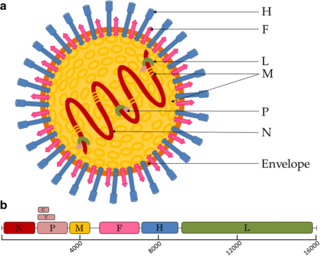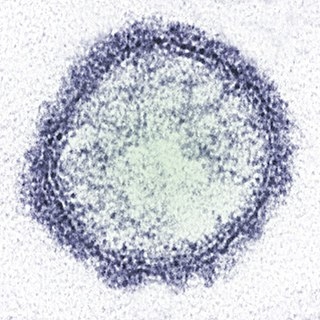
Flaviviridae is a family of enveloped positive-strand RNA viruses which mainly infect mammals and birds. They are primarily spread through arthropod vectors. The family gets its name from the yellow fever virus; flavus is Latin for "yellow", and yellow fever in turn was named because of its propensity to cause jaundice in victims. There are 89 species in the family divided among four genera. Diseases associated with the group include: hepatitis (hepaciviruses), hemorrhagic syndromes, fatal mucosal disease (pestiviruses), hemorrhagic fever, encephalitis, and the birth defect microcephaly (flaviviruses).

Paramyxoviridae is a family of negative-strand RNA viruses in the order Mononegavirales. Vertebrates serve as natural hosts. Diseases associated with this family include measles, mumps, and respiratory tract infections. The family has four subfamilies, 17 genera, three of which are unassigned to a subfamily, and 78 species.

Orthohantavirus is a genus of single-stranded, enveloped, negative-sense RNA viruses in the family Hantaviridae within the order Bunyavirales. Members of this genus may be called orthohantaviruses or simply hantaviruses.

Bunyavirales is an order of segmented negative-strand RNA viruses with mainly tripartite genomes. Member viruses infect arthropods, plants, protozoans, and vertebrates. It is the only order in the class Ellioviricetes. The name Bunyavirales derives from Bunyamwera, where the original type species Bunyamwera orthobunyavirus was first discovered. Ellioviricetes is named in honor of late virologist Richard M. Elliott for his early work on bunyaviruses.

Orbivirus is a genus of double-stranded RNA viruses in the family Reoviridae and subfamily Sedoreovirinae. Unlike other reoviruses, orbiviruses are arboviruses. They can infect and replicate within a wide range of arthropod and vertebrate hosts. Orbiviruses are named after their characteristic doughnut-shaped capsomers.

Phlebovirus is one of twenty genera of the family Phenuiviridae in the order Bunyavirales. The genus contains 66 species. It derives its name from Phlebotominae, the vectors of member species Naples phlebovirus, which is said to be ultimately from the Greek phlebos, meaning "vein". The proper word for "vein" in ancient Greek is however phleps (φλέψ).

Orthonairovirus is a genus of viruses in the family Nairoviridae of the order Bunyavirales that include viruses with circular, negative-sense single stranded RNA. It got its name from the Nairobi sheep disease that affects the gastrointestinal tracts of sheep and goats. The vast majority, and perhaps all viruses in this genus are tick-borne viruses that can have human or other vertebrate hosts.

Orthobunyavirus is a genus of the Peribunyaviridae family in the order Bunyavirales. There are currently ~170 viruses recognised in this genus. These have been assembled into 103 species and 20 serogroups.
Bunyamwera orthobunyavirus (BUNV) is a negative-sense, single-stranded enveloped RNA virus. It is assigned to the Orthobunyavirus genus, in the Bunyavirales order.

Transmissible gastroenteritis virus or Transmissible gastroenteritis coronavirus (TGEV) is a coronavirus which infects pigs. It is an enveloped, positive-sense, single-stranded RNA virus which enters its host cell by binding to the APN receptor. The virus is a member of the genus Alphacoronavirus, subgenus Tegacovirus, species Alphacoronavirus 1.
Dabie bandavirus, also called SFTS virus, is a tick-borne virus in the genus Bandavirus in the family Phenuiviridae, order Bunyavirales. The clinical condition it caused is known as severe fever with thrombocytopenia syndrome (SFTS). SFTS is an emerging infectious disease that was first described in northeast and central China 2009 and now has also been discovered in Japan, South Korea, Vietnam and Taiwan in 2015. SFTS has a fatality rate of 12% and as high as over 30% in some areas. The major clinical symptoms of SFTS are fever, vomiting, diarrhea, multiple organ failure, thrombocytopenia, leukopenia and elevated liver enzyme levels. Another outbreak occurred in East China in the early half of 2020.

Schmallenberg orthobunyavirus, also called Schmallenberg virus, abbreviated SBV, is a virus that causes congenital malformations and stillbirths in cattle, sheep, goats, and possibly alpaca. It appears to be transmitted by midges, which are likely to have been most active in causing the infection in the Northern Hemisphere summer and autumn of 2011, with animals subsequently giving birth from late 2011. Schmallenberg virus falls in the Simbu serogroup of orthobunyaviruses. It is considered to be most closely related to the Sathuperi and Douglas viruses.
Sangassou orthohantavirus(SANGV) is single-stranded, negative-sense RNA virus species of the genus Orthohantavirus in the Bunyavirales order. It was first isolated in an African wood mouse (Hylomyscus simus) in the forest in Guinea, West Africa in 2010. It is named for the village near where the mouse was trapped. It is the first indigenous Murinae-associated African hantavirus to be discovered.
In 1954 the Hazara orthonairovirus, one of the 34 tick-borne viruses of the genus Orthonairovirus, was discovered in Pakistan in the Ixodes tick native to that region. Today this virus is studied in mice in an attempt to develop treatments for the highly pathogenic Crimean-Congo Hemorrhagic Fever virus.
Batai orthobunyavirus (BATV) is a RNA virus belonging to order Bunyavirales, genus Orthobunyavirus.
Cache Valley orthobunyavirus (CVV) is a member of the order Bunyavirales, genus Orthobunyavirus, and serogroup Bunyamwera, which was first isolated in 1956 from Culiseta inornata mosquitos collected in Utah's Cache Valley. CVV is an enveloped arbovirus, nominally 80–120 nm in diameter, whose genome is composed of three single-stranded, negative-sense RNA segments. The large segment of related bunyaviruses is approximately 6800 bases in length and encodes a probable viral polymerase. The middle CVV segment has a 4463-nucleotide sequence and the smallest segment encodes for the nucleocapsid, and a second non-structural protein. CVV has been known to cause outbreaks of spontaneous abortion and congenital malformations in ruminants such as sheep and cattle. CVV rarely infects humans, but when they are infected it has caused encephalitis and multiorgan failure.
Soybean vein necrosis orthotospovirus is a plant pathogenic virus of soybeans. SVNV is a relatively new virus, which was discovered in Tennessee in 2008 and has recently been found in many US states from the Southeast and East coast to some western states including CA. This pathogen initially causes intraveinal chlorosis (yellowing) in leaves. This chlorosis then spreads throughout the leaf and eventually these chlorotic areas can become necrotic. It is a member of the order Bunyavirales, family Tospoviridae and genus Orthotospovirus, which is the only genus within this virus family that infects plants. Like other members of Bunyavirales, this virus is enveloped and has a negative sense single-stranded RNA (−ssRNA) genome composed of three genomic segments. It encodes proteins on the M and S segments in an ambisense manner.
The Punta Toro virus is a member of the genus Phlebovirus of the order Bunyavirales. It was initially isolated from patients in Colombia and two key patients in Panama. Two individual serotypes of PTV were isolated from these patients, PTV-Adames (A) and PTV-Balliet (B), with PTV-A appearing to be more virulent. PTV is considered to be relatively contained to the Americas with no cases being reported outside of this region. Along with a few other human pathogenic Phleboviruses, PTV is considered to be a significant virus in terms of public health as little information is known about its clinical effects and with further research underway, PTV could have unforeseen impacts on health and virology.

Phenuiviridae is a family of negative-strand RNA viruses in the order Bunyavirales. Ruminants, camels, humans, and mosquitoes serve as natural hosts. Member genus Phlebovirus is the only genus of the family that has viruses that cause disease in humans except Dabie bandavirus.

Bacilladnaviridae is a family of single-stranded DNA viruses that primarily infect diatoms.











